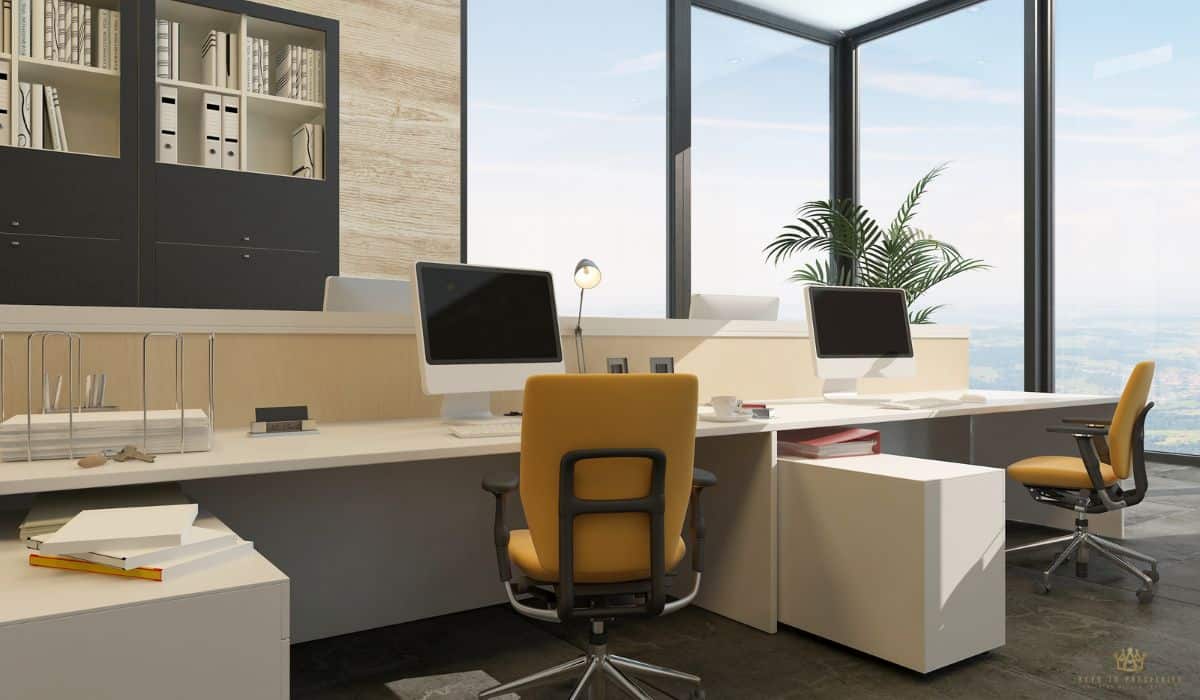
Look at these numbers: Office vacancy rates hit a staggering 19.9% across America in March 2025, while daily workplace attendance has stalled at 54%. These aren’t just statistics. They’re a wake-up call for landlords and businesses everywhere.
From our experience, a thoughtful office space value-add redesign strategy isn’t optional anymore. It’s essential for survival in this challenging commercial landscape.
This article connects to our broader value-add commercial real estate strategy content series. If you’ve read our previous piece on commercial property development risk assessment, you’ll find these redesign principles build logically on those foundations.
Stay tuned for our upcoming guide on repositioning strategy for retail properties, where we’ll explore similar transformation concepts for retail spaces.
Short Summary
- Office vacancy rates have reached a historic high of 19.9% in March 2025, making strategic redesigns critical for property owners and businesses
- A well-executed office space value-add redesign strategy balances spaces for collaboration and focused work to accommodate modern workplace needs
- Incorporating company’s values through thoughtful office design significantly improves employee satisfaction and reinforces company culture
- Environmental factors such as natural light, air quality, and natural elements have a measurable positive effect on productivity and wellbeing
- Successful implementation requires careful planning, realistic budgeting, and post-project measurement of key performance indicators
Creating A Modern Workplace That Reflects Your Company’s Identity
Having nice furniture and open spaces is great for a modern workplace. More than that, though, it’s also about telling the story of who your company is.
Every wall, color, and corner should reflect your company’s values in a way that employees, clients, and even potential employees can feel. Let’s break down how we’ve seen this done right, and how you can make it work for your business too.
How Office Design Communicates Values And Culture
The right office design quietly shapes company culture every day. For example, we once saw a tech company create an entire floor of open social spaces to promote innovation and collaboration.
That simple design choice immediately encouraged their team to share ideas more freely.
On the flip side, using glass walls instead of opaque ones sends a message of transparency, something many companies want to reinforce without saying a word.
Assessing Current Space Utilization With Data And Feedback
Before redesigning office space, it’s key to know how it’s actually being used. We often suggest running a quick survey to get feedback on what employees like and what they avoid.
Pair that with real data from booking systems and occupancy sensors. One example: after noticing that only 30% of private rooms were used regularly, a client decided to rework those into flexible hubs instead. That change boosted employee satisfaction almost immediately.
Incorporating Identity Through Strategic Design
There’s real power in using branding elements like colors, materials, and even furniture shapes to mirror a company’s identity. One creative group we saw used vibrant blues and greens in their office space, matching their logo and reinforcing their energy-focused mission.
Other practical ways to represent your company include:
- Custom wall art featuring your mission statement
- Furniture layouts that emphasize collaboration
- Signage that highlights core achievements
Using Zones To Reinforce Company Values
Creating specific zones that encourage certain behaviors helps build the environment you want. For instance, setting up quiet focus pods shows respect for deep work. Meanwhile, lively break areas support community building.
We’ve seen great success when offices mix heads-down areas with inviting gathering spots. It’s a direct reflection of respecting both focused work and teamwork.

Example Of Successful Alignment
In one case, a marketing firm revamped their traditional office layout to match their “creativity-first” mantra. They added writable walls, cozy brainstorming nooks, and casual meeting zones with easy access to tech.
Within six months, they reported higher employee engagement and quicker project turnaround proof that a well-planned space can fuel success.
Office Space Value-Add Redesign Strategy: Balancing Collaboration And Focused Work
Finding the sweet spot between collaboration and deep focus is essential if we want our redesigned office spaces to actually work. Let’s get into how you can shape a value-add commercial real estate strategy that supports every part of your team’s workday.
Supporting Collaborative And Individual Work Needs
A smart office space value-add redesign strategy supports both heads-down work and group efforts. Ignoring either side risks a drop in productivity.
Companies thrive when their offices offer plenty of options: spots to chat and brainstorm, and spaces to hunker down without distraction.
Strategies For Effective Social Spaces
Social spaces should feel natural, not forced. Think comfy lounge areas, oversized tables for impromptu meetings, or even casual café-style setups.
In one project, setting up a “collaboration corridor” with open seating led to a 15% spike in cross-department projects; not bad for just moving around some furniture.
When designing social spaces:
- Use modular furniture that’s easy to rearrange
- Choose durable, welcoming materials
- Place social zones near high-traffic areas to encourage casual meetups
Meeting Rooms For Different Purposes
Not every meeting needs the same setup. Tailoring spaces makes a big difference.
- Small rooms for quick huddles or one-on-ones
- Medium rooms for brainstorming or team updates
- Larger rooms with full tech setups for client presentations or hybrid team calls
For example, creating multiple small meeting rooms helped one company cut down wait times for spaces by 40%.
Informal Gathering Areas For Spontaneous Interaction
You want those “bump-into” moments to happen. Lounge nooks, open seating near coffee bars, or pop-up brainstorming boards can make spontaneous chats a normal part of the workday.

Designing Spaces For Focused Work
Heads-down work deserves just as much attention. Some practical moves include:
- Quiet zones away from social areas
- Dedicated focus rooms with minimal distractions
- Adjustable desk setups with noise-canceling panels
Acoustic Solutions And Privacy For Open Plans
In open offices, it’s smart to layer in acoustic solutions. Things like acoustic wall tiles, desk dividers, and white noise machines reduce distractions fast.
We also recommend adding semi-private booths or pods for solo work. They strike a nice balance between openness and privacy.
Creating The Right Mix Based On Team Needs
Use feedback surveys, occupancy data, and even simple space-use observations to find the right balance. Some teams may need 70% focus areas, others might lean 60% toward collaboration.
Tailoring your layout based on actual habits instead of guesswork makes redesigns way more successful.
Supporting Hybrid Models And Varying Occupancy
Hybrid work models bring extra challenges. Spaces need to flex whether there are 10 or 100 people in the office.
Integrating technology like easy video conferencing setups, booking apps for desks, and smart whiteboards can make in-office and remote collaboration seamless. Plus, flexible layouts with movable partitions keep the office feeling right no matter how many people show up that day.
Environmental Factors That Drive Productivity and Satisfaction
Getting the environment right can make or break how people feel and perform at work. Let’s look at how the right light, air, and natural touches can seriously boost productivity and employee satisfaction.
Importance Of Natural Light For Productivity
Sure, natural light is nice, but it’s also a key driver of better work performance. Studies show that access to daylight can improve focus and even reduce absenteeism. From our experience, teams working near windows reported feeling more energized throughout the day.

Strategies For Maximizing Daylight Penetration
You can make the most of natural light without tearing down walls. Some easy strategies include:
- Using glass partitions instead of solid walls
- Choosing light-colored paint and reflective surfaces
- Keeping window areas free from bulky furniture
Offices can increase daylight coverage by up to 25% just by rearranging layouts and swapping darker materials.
Solutions For Limited Window Access
Not every space gets flooded with sunshine, but there’s still hope. Smart solutions for darker spots include:
- Installing skylights or solar tubes when possible
- Using daylight-simulating LED fixtures
- Strategically placing mirrors to bounce available light
You can also try adding tunable lighting that shifts with the day. This light helps mimic natural rhythms even in windowless zones.
Air Quality Improvements And Their Benefits
Good air quality is a must, especially when aiming for a healthier, sharper workforce. Poor air circulation can quietly chip away at focus and energy.
HVAC System Upgrades For Better Circulation
Modern HVAC systems with upgraded filters and improved airflow design make a noticeable difference. Sensors that monitor CO2 levels and adjust air circulation automatically are a game-changer for maintaining alertness.
Air Purification Options For Healthier Environments
Beyond HVAC, stand-alone air purifiers, especially ones with HEPA filters, can help clean indoor air. Some companies even install living green walls, which naturally filter pollutants while looking great.
Biophilic Design: Incorporating Natural Elements
Biophilic design taps into humans’ natural love for nature, and it’s easy to implement. Ideas we’ve seen work well:
- Adding plenty of real plants throughout the space
- Using natural materials like wood, stone, or cork
- Creating indoor gardens or small green spaces
Even a handful of plants placed strategically can lift mood and improve indoor air quality.
Noise Management Techniques For A Productive Environment
Managing noise levels is critical, especially in open offices. Loud environments distract faster than we realize.
Key moves to control sound include:
- Installing acoustic ceiling panels or wall treatments
- Adding carpets or soft furnishings that absorb noise
- Using sound masking systems to create a steady, unobtrusive background hum
Another smart tactic is zoning: grouping quiet, focused work areas away from collaboration hubs or social spaces.
Implementing Your Redesign: Process, Budget, And Measuring Success
Once you’ve nailed down your office space value-add redesign strategy, it’s time to put the plan into action.
Here’s how to move from ideas to a finished workspace without losing your mind or your budget:
Streamlined Process For Planning And Executing The Redesign
A good plan is the difference between a smooth project and a total mess. Smart steps we’ve seen work include:
- Assembling a team early that includes leadership, HR, and a few employees
- Setting clear goals for the project timeline and phasing
- Holding regular check-ins to keep everything on track
Creating realistic timelines is critical. It’s tempting to rush, but even simple redesigns take weeks, not days.

Communication Strategies To Manage Employee Expectations
Transparency goes a long way. Share the vision and milestones upfront, and give employees chances to offer feedback. One company we observed hosted “sneak peek” sessions during the build-out, which kept morale high.
Budgeting Frameworks For Maximizing ROI
Redesigns can be pricey, but smart planning protects your return on investment. Here’s a breakdown that’s helped others:
- Value engineering early by identifying needs vs. nice-to-haves
- Setting aside a 10-15% contingency for surprises
- Investing heavily in areas employees touch daily, like workstations and lounge spaces
It often makes sense to save on decorative elements that don’t impact function, and instead, put funds into better HVAC, lighting, or tech upgrades.
Minimizing Disruption During The Fit-Out Process
Phased construction can keep businesses running even while improvements happen. Temporary work zones, off-hour construction, and clear communication help minimize headaches for everyone.
Key Methods For Measuring Success
After the dust settles, it’s important to check how well the redesign is working. Practical ways to measure include:
- Conducting employee satisfaction surveys focused on the new environment
- Tracking productivity metrics before and after the move
- Running space utilization analysis to see how different areas are used
- Monitoring recruitment data to gauge if the new space attracts better talent
The best part? When you combine real feedback with usage data, you’ll know exactly what worked and what you might tweak next time.
Final Thoughts
Designing an office that reflects your company’s identity and supports your team’s needs isn’t just a nice-to-have anymore. Today, it’s essential for staying competitive.
A thoughtful office space value-add redesign strategy can help create a space that employees are proud of and where clients feel welcome. Start small if you need to, but stay consistent with your vision.If you’re ready to explore more ideas for improving your workspace and boosting your property’s potential, we invite you to check out our homepage for helpful resources and insights. Let’s build something great together.
Frequently Asked Questions
How Much Should I Budget For An Office Redesign Project?
Most office redesigns require investing 10-15% of your total budget in contingency planning for unexpected issues.
Focus your spending on areas employees interact with daily (workstations, collaborative spaces) while saving on purely decorative elements that don’t directly impact function or productivity.
How Can I Accommodate Both Hybrid Workers And Full-Time Office Employees?
Integrate flexible workspaces with movable partitions and implement technology solutions like desk booking systems and video conferencing setups in meeting rooms.
Creating adaptable layouts ensures your office feels appropriately sized, whether occupied by 10 or 100 employees on any given day.
What Quick Improvements Can Make The Biggest Impact On Employee Satisfaction?
Improving natural light access, adding natural elements like plants, and creating dedicated zones for different work styles typically yield the highest satisfaction returns.
Simple acoustic solutions to manage noise levels can also dramatically improve the experience of working in open plan environments.
How Do I Measure If My Office Redesign Was Successful?
Conduct pre- and post-project employee satisfaction surveys, track productivity metrics before and after implementation, analyze space utilization data, and monitor recruitment and retention statistics.
These measurements will provide concrete data on whether your redesign has achieved its intended goals.






